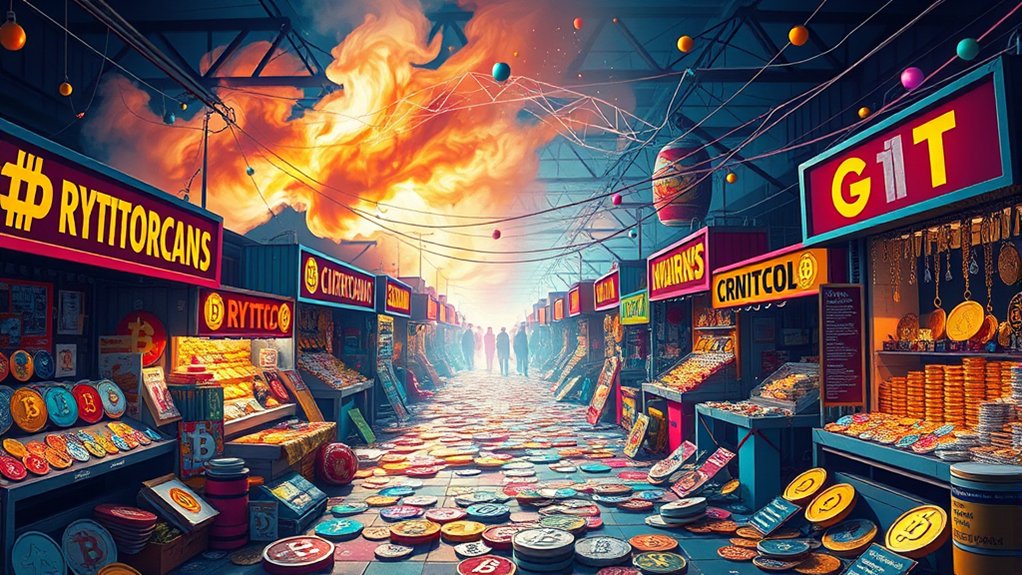The crypto scene is like a crazy jungle. Nearly 10,000 cryptocurrencies exist, each trying to fill a unique need or gap in the market. Some are for payments, others are pegged to the dollar for stability, and let’s not forget DeFi tokens and NFTs. Sure, it seems chaotic, but every coin or token aims to solve a specific problem. If you stick around, you might just uncover the wild world of crypto even further.

Cryptocurrency is a wild, untamed beast. With nearly 10,000 cryptocurrencies out there, it’s like a jungle, and every day, new species pop up. Why so many? Well, they’re not all just shiny coins waiting to be collected. Some are designed to be payment methods, like Bitcoin—the OG of crypto. It’s a peer-to-peer cash system, but don’t expect it to win any speed races.
Enter Litecoin, which zooms ahead with quicker transactions. But hold your horses; volatility is like a roller coaster. Good luck using them for daily purchases!
Then there are stablecoins. These guys are trying to be the calm in the storm, pegged to the U.S. dollar or other fiat currencies. They’re like that friend who always brings snacks to a party—comforting, but they come with risks, like issuer insolvency. Sure, they’re great for cross-border payments, but remember, nothing’s perfect. Stablecoins combine the benefits of blockchain technology with financial stability, making them integral to the cryptocurrency ecosystem.
Stablecoins aim to bring stability to the crypto chaos, but watch out for risks lurking in the background!
Tokens? Oh boy. Most of them hitch a ride on existing blockchains like Ethereum. They’re the utility players in the cryptocurrency world. You want to lend or borrow? There’s a DeFi token for that. Want to own a digital cat? Check out the NFTs. They’re unique, and you might be left wondering why you just bought a digital picture of a cat in a space suit for a fortune.
Infrastructure cryptocurrencies are the backbone of this ecosystem. They’re the platforms where everything else is built. Think Ethereum, enabling smart contracts and dApps. These are the heavy hitters, focusing on scalability and flexibility—because let’s face it, nobody wants a slow system when there’s money to be made.
In short, the variety in cryptocurrencies comes from innovation. Each new coin or token tries to fix something, filling gaps left by the last. It’s a chaotic, ever-evolving landscape, and it’s only getting wilder.
Frequently Asked Questions
How Do I Choose the Right Cryptocurrency for Investment?
Choosing the right cryptocurrency? Good luck with that!
First, look at the basics—what’s its purpose? Bitcoin is solid, but others? Who knows.
Analyze market trends and trading volume—it’s a wild ride! New coins can rocket or flop.
Diversify, or don’t—let’s face it, it’s a gamble. Remember, invest only what you can afford to lose.
And if you’re looking for stability, well, stablecoins might be your best friend.
Good luck!
What Are the Risks of Investing in Cryptocurrency?
Investing in cryptocurrency is like jumping into a rollercoaster blindfolded. Market volatility? Check. Prices swing wildly, driven by hype and panic.
Regulation? Good luck! It’s a wild west out there, with no safety net.
Security? Hackers love these digital coins. User error? Forget that password? Tough luck.
And don’t even think about getting your money back if something goes wrong. It’s risky business, folks. So, buckle up and hold on tight!
How Can I Securely Store My Cryptocurrency?
Storing cryptocurrency securely? It’s a game of cat and mouse.
Hot wallets? Convenient, but hackers love them. Cold wallets? Now we’re talking security, but good luck with instant access. Choose wisely.
Providers like Ledger and Coinbase have options galore, but remember: even the best can falter. Two-factor authentication is a must.
And for heaven’s sake, avoid public Wi-Fi. It’s like inviting trouble. Stay smart, or risk losing your shiny digital coins.
Are Cryptocurrencies Regulated by Governments?
Yes, governments are getting involved in the cryptocurrency scene.
In the U.S., agencies like the SEC and CFTC are trying to figure out how to categorize these digital coins. The Financial Innovation and Technology for the 21st Century Act is on the table, aiming to clear up the messy regulations.
Overseas, countries are also making their own rules. It’s a wild west out there, and regulators are scrambling to catch up.
What Is the Future of Cryptocurrency Technology?
The future of cryptocurrency technology looks like a wild ride. Blockchain is getting faster and more secure.
Smart contracts? They’re about to take over industries—banking and real estate, watch out!
DeFi is shaking things up, making finance accessible.
But let’s not forget the environment; green crypto is a thing now.
And security? It’s getting serious with AI and cool tech like Zero-Knowledge Proofs.
Buckle up, it’s gonna be a bumpy yet exciting journey!





